Production of cassava cuttings
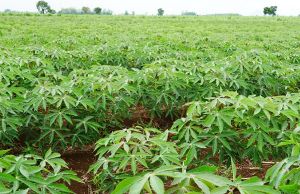
In the Bas-Congo Province, cassava is the main food and income source for households. However, cultivation is particularly sensitive to mosaic disease, and producers often face difficulties in acquiring sufficient quantities of resistant or tolerant varieties. To address this constraint, selected cassava cutting multiplication plots, or "wood yard," have been established in collaboration with the beneficiaries. The challenge of these cassava woodlot parks is therefore to produce and disseminate cassava varieties that are tolerant to mosaic disease.
Cassava
- Local name (Kikongo): Mayaka.
- Family: Euphorbiaceae.
- Genus: Manihot.
- Species: Esculenta.
- Varieties: TME419, 1661, Sadisa, Nsansi, Zizila, Butamu, and Rav.
Implementation Steps
Identifying the variety
Four criteria are crucial in identifying cassava varieties:
- Yield (number and size of roots).
- Duration of the cycle.
- Organoleptic quality for food processing (for example, in Congo, it is used for making fufu and chickwangue).
- Resistance or tolerance to mosaic.
- Varieties used in Bas-Congo: TME419, 1661, Sadisa, Nsansi, Zizila, Butamu, Rav, and M'vuazi.
Find the location
The choice of the location depends on the following technical indications:
- Topography: Bottom slope, gentle slope, plateaus, and plains.
- Average area: 2,500 m2.
- Soil types: Sandy-clayey, deep and well-drained, rich in organic matter (dark red or dark brown in color), with few gravels, having good water retention capacity and being easy to work (for plowing).
In addition to these criteria, some aspects of management need to be considered:
- Accessible on foot.
- Distant from diseased fields to avoid contamination.
- With a previous cultural practice of fallow or any other crop than root or tuber plants.
Identifying the period
Woodland establishment periods: season A (October to February: major rainy season) and season B (March to June: minor rainy season).
Determining the operations to carry out
- Delimitation of the land.
- Clearing.
- Plowing and/or ridging.
- Supply of cuttings.
- Preparation of cuttings and planting.
- Replenishment, weeding, and mulching.
- Ensure monitoring through visits to detect health problems (implementation of phytosanitation: eliminate and destroy plants showing any symptoms of diseases). Even if removing the plants represents a decrease in production.
Considerations
- Some cultivation practices are not well respected, such as ridging and mulching. Ridging, as those who plow with animal traction may not see its utility. For mulching, it is linked to the fact that they only use cut biomass, which is often insufficient to play a real mulching role.
- It is essential to take advantage of the first rains to have a maximum of precipitation during the cultivation cycle. Plants will have more vigorous growth and better resistance to diseases.
- Pay attention not to exceed the harvest date (12 to 18 months), as the obtained material may be of poor quality for planting.
Management of Cassava Woodlot
Preparation
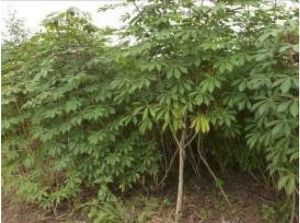
Without animal traction
- Delimit the plot.
- Clear without burning materials.
- Store a portion of the mowed grass for mulching, while the other part is reserved as fertilizer for burial (tufts, small grasses, root hair...). During making of ridges or mounds, it is advisable to effectively bury small weeds, green leaves, young tender stems of legumes, Tithonia diversifolia, or grasses present in the plots (Imperata cylindrica, Hyparrhenia sp,...) to ensure an organic element input.
- Uproot shrubs.
- Plow to a depth of 20 cm.
- Create ridges: 10 to 20 meters in length, 0.5 m wide, and spaced 0.5 m apart, following the contour lines.
- For mound crops: arrange the mounds following the contour lines and in a staggered pattern, 0.5 m in diameter at the top and 0.5 m apart from each other.
Light soil work and the burial of plant material are agroecological practices.
With animal traction
- Delimit the plot.
- Clear the grass and burn it after drying.
- 1 month after the first rains, plow by burying the recruits (young shoots that have regrown).
- Note: When the land is plowed by animal traction, the creation of ridges may be considered a waste of time by producers; however, the yield in roots is higher for ridge crops (manual preparation) compared to flat plowed fields (animal traction).
Planting
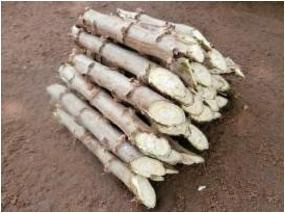
At the beginning of the rainy seasons (March and/or October):
- Harvest cassava stem cuttings from the middle part of the stem (once cut, they can be stored for 2 weeks).
- Segment the stem cuttings into cuttings of 20 to 25 cm before planting. Keep a minimum of 3 nodes per cutting to ensure successful sprouting.
- Plant cassava cuttings.
- Spacing: 0.75 m within the row (11 cuttings for a 10 m ridge) and 0.75 m between rows.
- Density: 1 cutting per location, planted horizontally or obliquely (2/3 of the length into the soil).
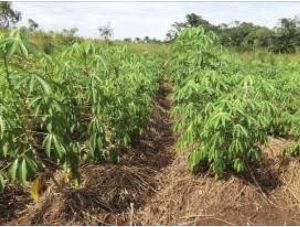
Maintenance
- Complete 4 to 6 weeks after planting.
- Weed 4 to 6 weeks after planting if necessary, and then as needed.
- Mulch: Cover the entire surface of ridges or mounds with stored or imported straw and with weeding residues. Supplement the mulch as needed during the cycle. It's an agroecological principle; permanent vegetation cover on the soil promotes fertility. Clear the mulch around the cassava stem base to prevent phytosanitary risks (rot, bacterial diseases).
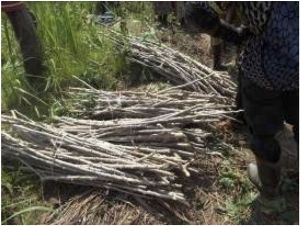
Harvest
- Cycle duration: 14 to 18 months.
- Cassava harvest can be spread over several weeks.
- Average yield in cuttings: 2,500 m² or 125 bundles of cuttings.
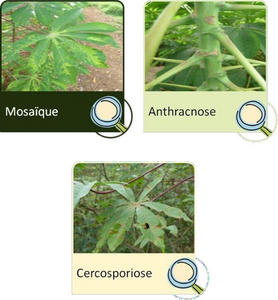
Protection
Major diseases
- Viral Disease: Mosaic is characterized by chlorotic spots (leaves discolor and exhibit light green, yellow, or white spots).
- Bacterial Diseases: They cause burns and wilting of leaves.
- Fungal Diseases: Cercosporiosis causing brown spots, Anthracnose manifesting as cankers (lesions), and rot that slows down growth.
Apart from cassava mosaic, which is highly prevalent in the Bas-Congo Province on local varieties, other diseases observed are isolated cases.
Recommendations
- Use healthy cuttings.
- Plant cassava clones that are resistant or tolerant to mosaic, bacterial diseases, and anthracnose.
- Plant at the beginning of the rainy season.
- Follow agricultural practices: Organic soil amendment, cuttings preparation, plowing, mulching, and crop rotation.
- Avoid visiting infected fields.
- Ensure phytosanitation: Eliminate and destroy plants showing any symptoms of diseases (remove them from the plot and burn them).
Sources
This page was written in partnership with the Urbane project and with the financial support of the European Union.

